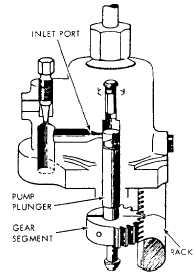check your manufacturer's repair manual for proper specifications and procedures.
Preventive maintenance is the most frequent type of servicing you will perform on a gasoline fuel injection system. Preventive maintenance consists of periodic visual checks and scheduled fuel filter service. Fuel filters are of the cartridge type, in line type, and disposable type.
All fuel injection system control sensors, such as temperature, oxygen, manifold absolute pressure, and so forth, (these are fully described in chapter 4 of this TRAMAN) are electrically connected to the electric control module (ECM). Some of these sensors, such as the oxygen sensor, have a regular maintenance cycle. Check your manufacturer's repair manual for special instructions pertaining to these sensors.
Be sure the air intake system is sealed properly. Early detection will save fuel and prevent engine damage. Air leaks are a problem to gasoline fuel injection systems. If the air leak is after the air filter, dirt will be ingested into the engine causing internal damage to the engine. Air leaks that bypass temperature sensors can cause false readings to be delivered to the ECM, changing injection quantity. Unmetered air leaks in the intake manifold can cause a lean fuel-air mixture to be delivered to the combustion chambers.
During regular maintenance and always after reassembly, you should check for fuel leaks. Gasoline leaks, however small, arc extremely dangerous. They must be dealt with immediately. Clean around all areas to be disassembled. Heavy layers of dirt and grime may make some leaks hard to find. Install new seals on leaking connections and replace cracked or leaking hoses.
CAUTION
Gasoline fuel injection systems operate with fuel pressures up to five times greater than that of standard gasoline fuel systems. Any replacement fuel lines used should be approved for higher pressures. Failure to do so will result in an unsafe fuel system on the vehicle with the danger of possible explosion and fire.
Clean around all areas before reassembly. When you tighten injector line nuts (injector head), use new seals and proper torque specifications. When you tighten fuel lines, use flare nut type of wrenches because regular open-end wrenches may damage these fuel line fittings.
Gasoline fuel injection systems have up to eight different manufacturers and over 21 different models. The 1990 edition of
Electronic Fuel Injection (Domestic) Diagnosis and Testing Manual by Mitchell is an excellent source for additional study on this subject.
DIESEL FUEL INJECTION SYSTEMS
When you studied the Construction Mechanic 3 & 2, you learned about general maintenance, removal, and replacement of diesel fuel; injection pumps, injectors, blowers, and turbochargers, as well as timing, minor adjustments, and repairs to the Caterpillar, International Harvester, General Motors, and Cummins diesel fuel systems. In this section, you will learn about the processes used to overhaul and troubleshoot diesel fuel and air induction systems.
CATERPILLAR FUEL INJECTION SYSTEMS
There are three types of Caterpillar fuel injection systems: the forged body, the compact, and the sleeve metering systems. While these systems serve the same purpose and you use common general troubleshooting procedures, each has an individual design. These systems have a capsule type of injector with a precombustion chamber that conditions the injected fuel for more effective combustion.
Forged Body Fuel System
The two main parts of the Caterpillar fuel injection system are the fuel injection pump (fig. 5-5), which times, meters, and creates the pressure needed for fuel

Figure 5-5.-Fuel injection pump.
Continue Reading